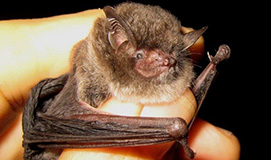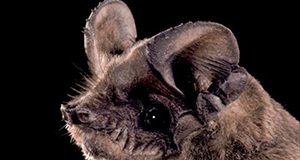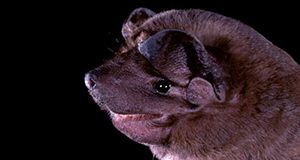The southeastern myotis is a small forest- and cave-dwelling bat that lives in Florida. Unlike many other species in Florida, southeastern myotis have long hairs between their toes that extend past their claws. You can learn to distinguish the southeastern myotis from other bats commonly found in Florida in this three-page fact sheet written by Emily Evans, Terry Doonan, and Holly Ober and published by the UF/IFAS Department of Wildlife Ecology and Conservation.
http://edis.ifas.ufl.edu/uw433
Tag: Bats
Florida's Bats: Tricolored Bat
The tricolored bat, formerly known as the eastern pipistrelle, is the smallest bat found in the state of Florida. It weighs just about as much as a nickel and a penny. Because of their small size and erratic flight pattern, tricolored bats are often mistaken for moths when seen in flight from a long distance away. You can learn to distinguish the tricolored bat from other bat species found in Florida with this three-page fact sheet written by Emily Evans, Terry Doonan, and Holly Ober and published by the UF/IFAS Department of Wildlife Ecology and Conservation.
http://edis.ifas.ufl.edu/uw434
Florida's Bats: Brazilian Free-tailed Bat
The Brazilian free-tailed bat lives throughout Florida and is the state’s most common bat. They are important economically because they consume large quantities of insect pests. This 2-page fact sheet written by Holly K. Ober, Terry Doonan, and Emily Evans, and published by the UF Department of Wildlife Ecology and Conservation explains how to differentiate Brazilian free-tailed bats from velvety free-tailed bats and Florida bonneted bats.
http://edis.ifas.ufl.edu/uw424
Florida's Bats: Velvety Free-Tailed Bat
The velvety free-tailed bat is found nowhere in the United States but extreme south Florida. These bats emerge from their roosts earlier than most other bats, often shortly before sunset. This 2-page fact sheet written by Holly K. Ober, Terry Doonan, and Emily Evans, and published by the UF Department of Wildlife Ecology and Conservation explains how to differentiate velvety free-tailed bats from Brazilian free-tailed bats and Florida bonneted bats.
http://edis.ifas.ufl.edu/uw425
Florida's Bats: The Florida Bonneted Bat
The Florida bonneted bat is one of only two endangered species of bat in Florida and the state’s only endemic flying mammal (“endemic” means that it is found nowhere in the world but in Florida). With a 20-inch wingspan, it is Florida’s largest bat and the third largest of all 48 species of bats in the United States. The Florida bonneted bat was listed as federally endangered in 2013 because of concerns over habitat loss, degradation, and modification caused by humans. Additional concerns include the species’ small population size and restricted range, the small number of known colonies, their slow reproduction, and the relative isolation of separate populations of bonneted bats. This 2-page fact sheet written by Holly K. Ober, Terry Doonan, and Emily Evans, and published by the UF Department of Wildlife Ecology and Conservation explains how to differentiate Florida bonneted bats from velvety free-tailed bats and Brazilian free-tailed bats and explains what to do if you find one of these endangered bats.http://edis.ifas.ufl.edu/uw426
Bats of Florida (WEC186/UW203)
Nocturnal habits, affinity for eerie places, and silent, darting flight have made bats the subjects of a great deal of folklore and superstition through the years. Given their ability to function in the dark when and where humans cannot, it is no wonder that bats have long been associated with the supernatural. Bats remain poorly understood even today. This revised 5-page fact sheet describes the species of bats that occur in Florida and provides simple tips for their identification. It was written by Holly K. Ober, Martin B. Main, and Ginger M. Allen and published by the UF Department of Wildlife Ecology and Conservation, November 2010.
http://edis.ifas.ufl.edu/uw203
WEC-247/UW291 Conservation of Bats in Florida
WEC-247, a 4-page illustrated fact sheet by Holly K. Ober and Frank J. Mazzotti, aims to dispel fears about bats and describe their benefits, facts about bats and their habitats and how individuals can promote bat conservation. Includes references. Published by the UF Department of Wildlife Ecology and Conservation, August 2008.
http://edis.ifas.ufl.edu/UW291
WEC-246/UW290 Effective Bat Houses for Florida
WEC-246, an 8-page illustrated fact sheet by Holly K. Ober, describes how to attact bats to your property, select a location for a bat house, how to mount it, reasons bats might stay away, and concerns. Includes references and bat house plans. Published by the UF Department of Wildlife Ecology and Conservation, August 2008.
http://edis.ifas.ufl.edu/UW290
WEC-245/UW289 Insect Pest Management Services Provided by Bats
WEC-245, a 4-page illustrated fact sheet by Holly K. Ober, uses a questions-and-answer format to provide information about this insect-eating animals role in reducing crop pests and mosquito populations in Florida, and what Floridians can do to attract bats to their property. Includes references. Published by the UF Department of Wildlife Ecology and Conservation, August 2008.
http://edis.ifas.ufl.edu/UW289




